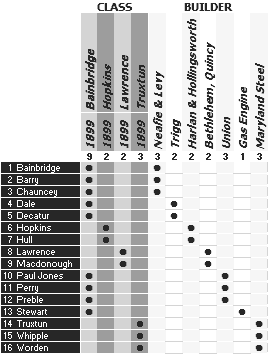



The four classes compared. Banner: Decatur (Bainbridge class). Above top: Hopkins. Above center: Lawrence. Above bottom: Worden (Truxtun class).
Nine of them—the Bainbridge class—were designed by the Navy Department. Recognition features included a high fo’c’s’le and four widely-spaced stacks. Their main batteries consisted of two guns of a new 3-inch/50 caliber rapid fire design. They also mounted five 6-pounders and carried two 18-inch torpedo tubes.

The remaining seven ships were designed by three private builders (all of which were later acquired by Bethlehem Steel): Harlan & Hollingsworth at Wilmington, Delaware (Hopkins class), Fore River at Quincy, Massachusetts (Lawrence class), and Maryland Steel at Sparrows Point, Maryland (Truxtun class). The seven substituted a turtleback forecastle for the Bainbridges’ raised foredeck but their armament remained the same, except that Paul Jones, Peary and Preble carried one twin torpedo tube mount instead of two singles and the Truxtuns carried one more 6-pounder. (Lawrence and Macdonough later proved unable to carry their 3-inch guns and replaced them with 6-pounders.)
Hulls in all cases were 246–260 feet overall length. Coal-fired boilers operated at 240 or 250 psi. Vertical, inverted triple-expansion reciprocating steam engines developing 7,000 to 8,400 shaft horsepower drove two screws, good for 28–30 knots. Complement was 72–75 officers and men.
Keels were laid between February 1899 and January 1900. The Bainbridges and Truxtuns were delivered in 1902; the others in 1903.
On 24 February 1916, the Navy Department decided that the sixteen were “no longer serviceable for duty with the fleet” and reclassified them as “coast torpedo vessels.” They nonetheless operated through World War I before being stricken from the Navy List in 1919 and sold for scrapping in 1920. The Truxtuns were subsequently converted as banana carriers. In 1942, ex-Worden was apparently sunk in this service by U-109; ex-Whipple was scrapped only in 1956.